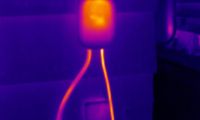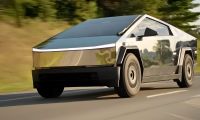Our Chevrolet Volt needed a chance to plug in for a while over Christmas week, so that meant that my Chevy Bolt EV needed to spend some time unplugged in during freezing overnight conditions. I’ve been attempting to track the Bolt EV’s battery thermal management behavior, so this gave me a great opportunity to spy on the inner workings of the Bolt EV using Torque Pro (an app that reads the car’s sensor data through the OBD2 port.

Before I start, I want to mention that while these winter conditions aren’t particularly harsh, they are cold enough to limit electric vehicle battery performance and trigger many of the Chevy Bolt EV’s thermal management systems. In this story, I will describe what I learned about the 2017 Chevy Bolt EV’s battery thermal management systems after leaving it unplugged in freezing overnight conditions for two days.
Chevy Bolt EV Vampire Drain
When I don’t have a long trip lined up, I prefer to leave my 2017 Chevy Bolt EV with “Hilltop Reserve” mode on. This mode was originally designed for Bolt EV owners who started their drives as higher elevations, and it provides full regenerative braking and additional battery capacity to recapture energy (which is otherwise limited when the battery is full). Hilltop Reserve limits the car to charging the battery to 88.2% (according to Torque Pro readings), so when I unplugged my Bolt EV and sent it to pasture, that’s how much capacity it had.

Just for reference, Hilltop Reserve was replaced in later model Chevy Bolt EVs. In 2019, GM introduced a new feature to the Bolt EV that enables the owner to set a “Charge Limit” in 5% increments.
For those who are unfamiliar, “vampire drain” is a term used to describe the power draw by an electric vehicle’s onboard electronics that slowly deplete battery capacity over time. Over the years, I’ve been able to confirm that whatever the Chevy Bolt EV’s vampire drain was, it was very low. When I first got the car, I hit a rock and blew out the tire, so my Bolt EV was left at about 4,000’ overnight in January while I picked up a replacement tire. The vampire drain was low enough then, that by the time I returned, the estimated range hadn’t changed.
Thanks to Torque Pro, I can now quantify just how much the battery capacity drained after two days with freezing overnight temperatures. When I turned on the car and checked Torque Pro, it displayed 87.8% battery capacity. So in two days, my Bolt EV had consumed less than .5% of its total capacity.
Chevy Bolt EV Internal Battery Temperature
In addition to checking my Bolt EV’s battery capacity when I started it up, I also checked the core battery temperature. Because the Bolt EV had been left out overnight without being plugged in, Torque Pro displayed that its core battery temperature had dropped to 35.6 degrees Fahrenheit. This is not unusual because I had seen similar internal battery temperatures on previous occasions when I had left the car unplugged. To contrast, with similar overnight temperatures but with the Bolt EV plugged in, it had maintained an internal battery temperature of 59 F.

I did notice something peculiar this time around when I had left the Bolt EV unplugged, however, and that was that it appeared to fine with the battery at 35.6 F. Previously, when I had left the Bolt EV unplugged (letting the battery temperature drop to the low 30s), the moment I turned the Bolt EV on, it started the battery heater. The only difference I can identify is that in the previous case, the car was still registering an outside temperature in the 30s.
This time, though, the outside air temperature sensor was exposed to the sun, and it was registering an ambient air temperature of 76.1 F. My guess is that something in the Bolt EV’s programming is telling it to not bother running the battery heater if the outside temperatures are high enough that it will eventually warm on its own.

However, the moment I shifted the Bolt EV into drive, the battery heater immediately engaged.
Chevy Bolt EV Battery Heating
The reason I was plugging my Chevy Bolt EV was that I was getting ready to make a 150-mile trip to do some shopping, so I wanted to start warming the battery and adding a little extra energy. As I drove over to our plug, the battery heater started drawing 2,333 watts (about 2.3 kW). By the time I made it to our charger, my Bolt EV had consumed 0.1 kWh with 64% of that energy being used for battery conditioning.

I turned off the Hilltop Reserve mode, plugged in the car, and shut it off. I knew I had about 30 minutes before we were going to leave, so I wanted to see how much the Bolt EV’s battery would warm while it was shut off and charging. To my surprise, the Chevy Bolt EV didn’t appear to run the battery heater aggressively when it was off and charging. The battery temperature had leveled off at 41 F when it was charging.

When I turned the Bolt EV back on, however, the battery heater immediately started, and it was now drawing 2,407 watts (2.4 kW). It continued to warm the battery until I unplugged, but I stopped monitoring it with Torque Pro at that point. What I could tell is that it continued to warm the battery as I was actively driving, which resulted in significantly lower efficiency than normal during the first 20 miles or so of driving.

By the end of the trip, the battery temperature had warmed to 62.6 F compared to an outside temperature of 47 F, and all of the energy consumed for battery conditioning no longer even accounted for 1% of the 43.5 kWh expended to complete the 160 mile trip.
Conclusion
While this is still just a snapshot of the Chevrolet Bolt EV’s battery warming parameters, it can still inform Bolt EV owners on how they should operate their vehicles during cold weather. The Bolt EV will not suffer significant vampire drain; however, it will consume a significant amount of energy warming the battery after it is turned on. For that reason, Chevy Bolt EVs should be left plugged into the charger during freezing conditions.

In addition, the Bolt EV will not warm the battery as aggressively when it is turned off, even if it is plugged in and charging. To properly warm the battery during harsh winter conditions, it might be necessary to actually turn the car on while it is still plugged in. This might also be more effective than “preconditioning” the car because the Chevy Bolt EV will only stay on for 20 minutes during precondition, but it will stay on for approximately 1 hour if turned on from inside the vehicle using the FOB.
Still, the Chevy Bolt EV’s onboard battery heater appears to be limited to 2.4 kW, so it still might not be capable of maintaining the battery’s ideal operating temperatures in very harsh winter climates.
See you in my next story where I am discussing Chevy Bolt trip planning issues and tips for better route planning.
About The Author
Eric Way focuses on reporting expert opinion on GM brand electric vehicles at Torque News. Eric is also an instructional designer and technical writer with more than 15 years of writing experience. He also hosts the News Coulomb video blog, which focuses on electric vehicles, charging infrastructure, and renewable energy. Eric is an active member of the EV Advocates of Ventura County, a volunteer organization focused on increasing the widespread adoption of electric vehicles. You can follow Eric on News Coulomb Youtube, on Facebook at @NewsCoulomb as well as on Twitter at @eway1978.













Comments
Another great article Eric,
Permalink
Another great article Eric, and more insight into the workings of our great little cars.
My Bolt stays outside 24x and
Permalink
My Bolt stays outside 24x and I live in Columbus. There were plenty circa 0 f nights I don't plug in and never noticed much vampire drain. I do notice that keeping the vehicle outside seems to give a more accurate guessometer (vs my brother's Kia)
My 2019 Bolt has 12,500 miles
Permalink
My 2019 Bolt has 12,500 miles and only get 183 miles on full charge. I'm not an elec.
techie at all. Might I have accidentally changed something? I ran it to 0 once desperately looking for a charge station. Dealer not much help. Absolutely love the car though
A projected range of 183
Permalink
In reply to My 2019 Bolt has 12,500 miles by Ralph Hutchison (not verified)
A projected range of 183 miles is not out of the question in unfavorable weather conditions. This is especially true if the HVAC is on the highest setting or the cabin heat is set to a high setting. The heater is a 1:1 ratio for heat generated to power consumed. The heater might draw 4 kW on the high setting. If the high voltage battery needs to be warmed, another 2 kW may be used. The power used to heat the cabin and battery might equal the power used to move the car on flat terrain - at least for a while after you start driving. As the cabin and battery warm up, you may be improvements in projected driving range as the heaters begin to consume less power. As with gasoline powered cars, the system works better when everything is a nice moderate warm temperature. The take-away is the same for electric and gas: try to group errands together so that the car will start off warm as you move from one errand to the next. Something you will find is that cooling the car uses a lot less energy from the battery than heating the car. The refrigerant circuit has close to 4:1 benefit of being able to remove much more heat energy from the cabin or battery than electric energy consumed by the refrigerant compressor.
So much depends on how you
Permalink
In reply to My 2019 Bolt has 12,500 miles by Ralph Hutchison (not verified)
So much depends on how you drive, how you set your climate control, what the outside temperature is, then is it city, highway, or turnpike speeds.
The "range" is a projection based on how YOU'RE operating the car. The listed 240ish mile range is based on ideal, operation and environmental conditions.
Unless you live in 75 degree all the time weather, I would ignore it. Pay more attention to what sort of miles/kW you get under certain situations. I would bet that if you brought up the screen that shows your average over 50 miles it would be right on the 3 miles/kW line.
Sticky brakes / calipers can
Permalink
In reply to So much depends on how you by Travis Burdess (not verified)
Sticky brakes / calipers can also yield rather low efficiency for a particular car. Just like gas cars. You'd see it if you did your own brake jobs and you'd care enough to clean/grease the sliders, techs not unless you get a particularly good one.
Cars that live where there's salt on the roads have rough lives. Its worth it.
Lots of useful factoids Eric-
Permalink
Lots of useful factoids Eric--especially about leaving the Bolt "on" as opposed to preconditioning. That's very helpful to know.
Paul
I appreciate the article
Permalink
I appreciate the article about cold weather battery conditioning but do not consider Eric to be a ‘expert’ .
I’ve been in the Electrical Engineering field for 45 years and consider this article slightly informative but definitely not ‘expert’.
CMU professors did the programming for the Volt and I’m assuming that technology is also incorporated in the Bolt.... they are the experts.
Automotive journalists today are far from ‘smokey’ a real expert journalist who wrote really good expert articles for Popular Science.
I do like reading articles about the Bolt.... and
This is a good article ...just should not be considered ‘expert’.. thanks.
Oh my, that makes me feel old
Permalink
In reply to I appreciate the article by Perry Kravec (not verified)
Oh my, that makes me feel old because I remember Smokey from Popular Science in the 1960s. I took the article above as as an empirical observation of rather specific conditions rather than an engineering analysis. John Kelly’s Weber University videos on-line are great sources for looking under the 2017 Bolt’s skin. No doubt the Helm manuals are a good information source, albeit an expensive option.
I found it helpful to know that the battery heater appears to have a higher output when the Bolt is switched on while plugged in, versus plugged in but pre-conditioning without being switched on.
I would take the author’s suggestion of switching on the car while plugged in and pre-conditioning with a grain of salt: indeed that is a configuration that is not specifically recommended in the owner’s manual, but not excluded either. Perhaps it is better not to second guess the designers’ intent and avoid operational conditions not explicitly known to be acceptable; it might be fine, but on the other hand maybe not good - the owner might not know which case until battery deterioration is observed.
Thanks for the article and
Permalink
Thanks for the article and the additional formation on the Bolt’s battery conditioning behavior. The information in the article squares with the recommendation of the Bolt’s owner’s manual which recommends that the Bolt be left connected to the charging equipment when the car is not in use. According to John Kelly of Weber University, the heater in the battery thermal loop is 2 kW and is programmed to stay on until the battery reaches 65 degrees F (2017 model).
According to Professor Kelly, there are three separate coolant loops in the Bolt as well as active grille shutters. One loop comprises the motor/drive and several electronics packages and is cooling only. The second loop comprises the battery, heater and a liquid-to-Freon heat exchanger that uses the air conditioner compressor Freon circuit when the battery needs to be cooled. The third loop is for conditioning the cabin air and contains a larger electric heater. There is Freon to air evaporator coil to cool and dehumidify cabin air as needed. The Bolt has a humidity sensor and will command the Freon circuit on even if the driver does not select A/C is the air in the cabin is too damp.
Hey Eric, Great meeting you
Permalink
Hey Eric, Great meeting you on the road at the charging stations.
Just a little FYI, I was
Permalink
Just a little FYI, I was looking for a way to keep my Bolt Ev running for an indefinite period. After a little experimentation I discovered that if you leave the car on in neutral it will run indefinitely. Mine ran for 10 hours overnight which is what I was trying to accomplish. My garage is flat, but I used the parking brake on as a precaution. It will also operate parking brake off and in nuetral, but beware the risks involved.
Thank you! Well done!
Permalink
Thank you! Well done!
It is using my house
Permalink
It is using my house electricity to keep the battery warm when I am at home. If the car was going to sit for a week wouldn’t it be more efficient to just let it go cold for a week and then warm it up before i use it(or just drive it)? Would that damage the battery?
Are there Torque Pro (or
Permalink
Are there Torque Pro (or other OBD monitors) that are iPhone apps? I do not see a Torque Pro app in the App Store. Thx.
I have not seen an iOS
Permalink
In reply to Are there Torque Pro (or by John Langmore (not verified)
I have not seen an iOS application as well done as Torque Pro for Android (there may be a good iOS application, but I have not found it). It is worth getting a cheap Android tablet just for running Torque Pro. You don’t need anything fancy. A cheap store brand Android tablet from Walmart would be more than powerful enough for Torque Pro and the cost might only be thirty or forty Dollars. Avoid completely generic unknown brands as those may have unwanted permanent applications which expropriate your personal information without your permission.
For use with Torque, I got a Wi-Fi enabled ODB-II monitor made by BAFX for about twenty Dollars. There are less expensive adapters out there, but they are poor clones of the ELM-327 protocol and often don’t work properly. The PIC chip in the BAFX unit does have an ELM Electronics copyright notice stamped on it, however that may or may not guarantee the chip is real. At least the device seems to work properly. I used the same adapter successfully with LEAF Spy back when I had a LEAF.
Thank you for your article,…
Permalink
Thank you for your article, Eric.
I found it while searching for advice on my situation. If I interpreted your results - and other responses - correctly, I think I should be okay.
I am visiting some friends (~30 miles, one-way) where my 2020 Chevy Bolt EV will have to sit outside, unplugged for 4 nights. The night-time temps will be 15 - 30 F° and daytime 30 - 50 °F. I will likely not drive the car during my stay there. No precipitation forecasted and it will be in the sun during daylight.
I think I should be okay without experiencing too much battery drain, right? Although there are charging stations in towns nearby, most are 2nd level charging, so I prefer making the round-trip on an 80% charge, if possible.
Thank you for your input.
Thanks for sharing your…
Permalink
Thanks for sharing your results in this detailed article! Very interesting to see what the actual draw and battery temps were. With the current artic blast I’d be interested to know how far below freezing it was when you took your readings.